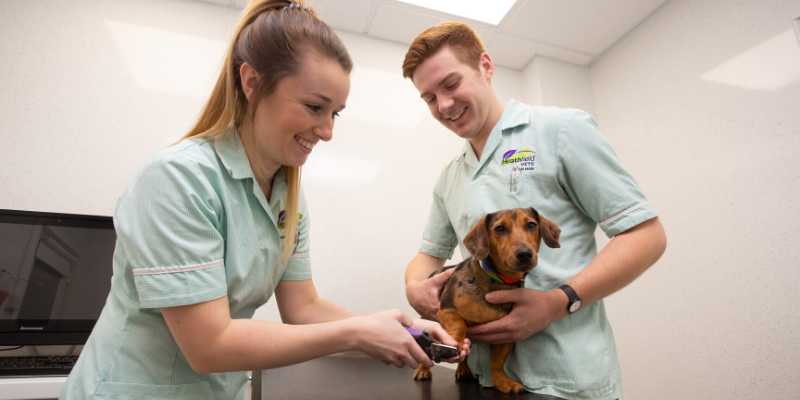Acclimatising Your Dog to Nail Trimming
We come across many animals (mostly dogs) that dislike their paws being touched. In ideal circumstances cats, dogs and small furries will have been acclimatised to having their feet touched and nails trimmed from a young age, but this is often not the case.
Initially, incorporate stroking their feet into their playtime to desensitise them. For dogs, get them to sit and wait whilst you lift each paw and examine each toe and claw. Increase the time you do this for slowly; going too quickly can cause them to get scared of their feet being touched. Depending on whether they are food or toy orientated, provide rewards for good behaviour! This will help them to associate this with being a positive experience.
Once they are used to their claws and toes being played with, use a metal spoon to touch the claws and gently tap them. Often dogs become scared of the feeling of metal from nail clippers, so this will get them used to the cool sensation of metal on their feet. Again, provide rewards for good behaviour and take time with this process.
You can aid the process by using some stress reducing aids such as pheromone sprays and plug-ins. Distraction can also be useful, some people swear by dog-safe peanut butter!
Other Ways To Keep Your Dog’s Nails Trimmed
Your dog’s nails will wear down naturally as they walk on hard pavements, so spend some portion of your daily walks off the grass. You can also try filing your dog’s nails, though this will take time and patience and will likely take longer, so may cause them more stress depending on each individual pet.
In ideal circumstances, your pet’s nails will be trimmed before they get too long. An easy way of identifying if they are too long is if their claws click whilst their walking across a hard floor. Ultimately, it can disrupt how they walk and become painful, particularly if they have arthritis in their paws.
Nail Clipping
If your dog is unsure about having their nails clipped, you may have to have multiple sessions. Doing too much too quickly can be traumatic for them and they will then make them harder to handle next time.
The longer nails get, the longer the quick (blood supply) of the nail gets. You want to avoid clipping this section of the nail as much as possible, carrying out multiple small clips and making your way up slowly before you go too far. If you ‘catch’ the quick (cut into it) it will be painful for your pet and will bleed significantly.
When you do your next little clip, apply light pressure – not enough to clip the nail. If this pressure is over where the quick is, it will be uncomfortable for your dog and they will pull their leg back. It’s important to note that if they are particularly sensitive about nail clipping they will pull their leg back due to the pressure regardless, but this is a good indicator in dogs that tolerate nail clipping well.
In white nails you can see the quicks as the pink pigment in the nail, so you want to clip just below where the pink tip ends. Still, do multiple small clips as white nails can be deceiving too.
Black nails are trickier! You are unable to visualise the pink quick as the nail colour is black, therefore you need to clip back to the pulp which is just before the kwik. As you clip, you will see a white colour on the cut surface. This means you have not reached the pulp yet. The pulp is located just before the quick. It is dark in colour but able to be identified by a circular appearance. Keep trimming until you reach this point and then stop! If you are not sure, trim the nail only very slightly so that it is not tapping on the floor and do nail trims more regularly.
How To Handle Your Dog
It is best to have someone restrain your pet whilst clipping their nails.
The most important part of handling a dog is holding onto their head. Accidentally catching a quick is very painful and it may cause even the nicest dogs to bite someone. Wrap one arm around the dog’s neck and hold onto their head.
Use the other hand to hold onto the leg that is being clipped, it is best to tuck your hand in to their armpit to push out against their elbow, you will have the most grip there.
If they keep going backwards and you have no one to be a bum stop, it can be helpful to get them to sit with their bum tucked into the corner of a room, this will stop them wriggling backwards!
Distraction with treats is always beneficial, so long as they will sit still and do not get so excited that it makes them wriggle more.
Some dogs just need gentle restraint around the head whilst being distracted with treats
If they dislike their feet being touched, you can leave them on the floor and try to slip the clippers around them, clipping small amounts at a time.
If You Catch A Quick
Keep a towel or a soft material handy when clipping nails. The kwik is the blood supply to a nail, therefore they bleed heavily when caught. Eventually they will stop bleeding by themselves but in the interim, you can apply pressure with a towel or something soft. Once you have applied pressure, keep the pressure on! The pressure you are applying is acting like a blood clot, so once removed, it will start bleeding again. Test removing pressure after a few minutes, if blood appears again, apply pressure for a few more minutes and so on. For these reasons it is not advised to clip nails on a carpet, best to do on hard floors which are easily cleaned. There also products you can buy to stop the bleeding quickly, such as caustic pencils, but do be aware that these may sting when applied!
The Best Clippers To Use
We recommend investing in a good pair of clippers that have sharp blades to cut the nail cleanly so there are no ragged edges that need filing. Good clippers will mean when you make the cut on the nail, you only need to use a gentle squeeze on the clippers to do it, clipping the end of the nail off easily which is much more comfortable for your pet. Look for clippers that come with a safety stop, allowing you to only trim small amounts at a time, this stops you from clipping too much at once. Buy a pair for the appropriate size for your pet, dog clippers typically come in different sizes depending on the breed whilst small cat clippers can be used for cats, rabbits and puppies.
Nail Injuries and Abnormalities
Nails that have torn can be painful for your pet and can lead to infection if not treated, we recommend calling your vet for advice if you notice a torn nail rather than just cutting it off. Torn nails may not regrow properly if not taken care of which can cause longer term issues. Nails which have overgrown into your pet’s foot will also need vet attention. If you notice that your pet’s nails seem to have worn unevenly, this may be an indicator of an underlying issue such as arthritis or hip dysplasia.
If you are not confident in your ability to cut your pet’s nails, you may want to consider seeking out a reputable and insured dog groomer or in more difficult cases, contacting us to discuss your pet’s needs so that we can advise you.
Call us on 01435 864422 if you have any questions about grooming your pet.


